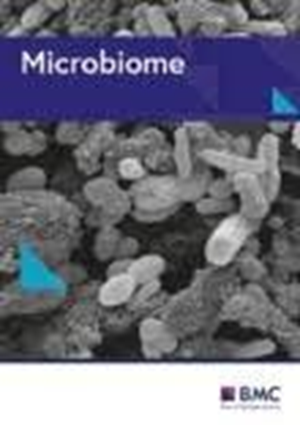微生物定植重塑了杨树根渗出物、根和芽代谢组的组成和含量
IF 13.8
1区 生物学
Q1 MICROBIOLOGY
引用次数: 0
摘要
树木与其寄主不同组织中定植的各种微生物有关。然而,从根到芽轴的微生物群组装微生物群的早期动态及其与根渗出物和组织代谢物含量之间的联系仍不清楚。在此,我们研究了真菌和细菌群落如何在杨树插条(杨树 x tremuloides 克隆 T89)生长 30 天的同时改变根渗出物以及根和芽代谢组。无菌杨树插条被种植在天然土壤或伽马辐照土壤中。从第 1 天到第 30 天,采集了大量土壤和根瘤土壤、根和芽组织,通过 DNA 代谢编码追踪不同生境中真菌和细菌群落的动态变化。同时还采用气相色谱-质谱法分析了根部渗出物以及根和芽的代谢物。我们的研究表明,微生物的定植会导致根系渗出物的成分和数量发生快速而显著的变化,在没有微生物的情况下,有超过 70 种代谢物的丰度非常高。其中值得注意的是与脂质有关的代谢物和防御化合物。根部和芽部的微生物定殖也表现出类似的动态反应,最初是吸食性微生物,后来过渡到内生菌和共生菌。在根圈和根部的较早时间点,也能看到嫩枝微生物群的主要成分,这表明土壤是嫩枝微生物群的主要来源。此外,微生物在地下和地上部分的定殖引起了植物新陈代谢的重新配置。具体来说,微生物定殖主要改变了根系的初级代谢,而在芽中,微生物定殖主要影响防御代谢。这项研究强调了微生物相互作用对植物代谢途径的深远影响,揭示了植物与其相关微生物群落之间错综复杂的相互作用。本文章由计算机程序翻译,如有差异,请以英文原文为准。
Microbial colonisation rewires the composition and content of poplar root exudates, root and shoot metabolomes
Trees are associated with a broad range of microorganisms colonising the diverse tissues of their host. However, the early dynamics of the microbiota assembly microbiota from the root to shoot axis and how it is linked to root exudates and metabolite contents of tissues remain unclear. Here, we characterised how fungal and bacterial communities are altering root exudates as well as root and shoot metabolomes in parallel with their establishment in poplar cuttings (Populus tremula x tremuloides clone T89) over 30 days of growth. Sterile poplar cuttings were planted in natural or gamma irradiated soils. Bulk and rhizospheric soils, root and shoot tissues were collected from day 1 to day 30 to track the dynamic changes of fungal and bacterial communities in the different habitats by DNA metabarcoding. Root exudates and root and shoot metabolites were analysed in parallel by gas chromatography-mass spectrometry. Our study reveals that microbial colonisation triggered rapid and substantial alterations in both the composition and quantity of root exudates, with over 70 metabolites exclusively identified in remarkably high abundances in the absence of microorganisms. Noteworthy among these were lipid-related metabolites and defence compounds. The microbial colonisation of both roots and shoots exhibited a similar dynamic response, initially involving saprophytic microorganisms and later transitioning to endophytes and symbionts. Key constituents of the shoot microbiota were also discernible at earlier time points in the rhizosphere and roots, indicating that the soil constituted a primary source for shoot microbiota. Furthermore, the microbial colonisation of belowground and aerial compartments induced a reconfiguration of plant metabolism. Specifically, microbial colonisation predominantly instigated alterations in primary metabolism in roots, while in shoots, it primarily influenced defence metabolism. This study highlighted the profound impact of microbial interactions on metabolic pathways of plants, shedding light on the intricate interplay between plants and their associated microbial communities.
求助全文
通过发布文献求助,成功后即可免费获取论文全文。
去求助
来源期刊

Microbiome
MICROBIOLOGY-
CiteScore
21.90
自引率
2.60%
发文量
198
审稿时长
4 weeks
期刊介绍:
Microbiome is a journal that focuses on studies of microbiomes in humans, animals, plants, and the environment. It covers both natural and manipulated microbiomes, such as those in agriculture. The journal is interested in research that uses meta-omics approaches or novel bioinformatics tools and emphasizes the community/host interaction and structure-function relationship within the microbiome. Studies that go beyond descriptive omics surveys and include experimental or theoretical approaches will be considered for publication. The journal also encourages research that establishes cause and effect relationships and supports proposed microbiome functions. However, studies of individual microbial isolates/species without exploring their impact on the host or the complex microbiome structures and functions will not be considered for publication. Microbiome is indexed in BIOSIS, Current Contents, DOAJ, Embase, MEDLINE, PubMed, PubMed Central, and Science Citations Index Expanded.
 求助内容:
求助内容: 应助结果提醒方式:
应助结果提醒方式:


